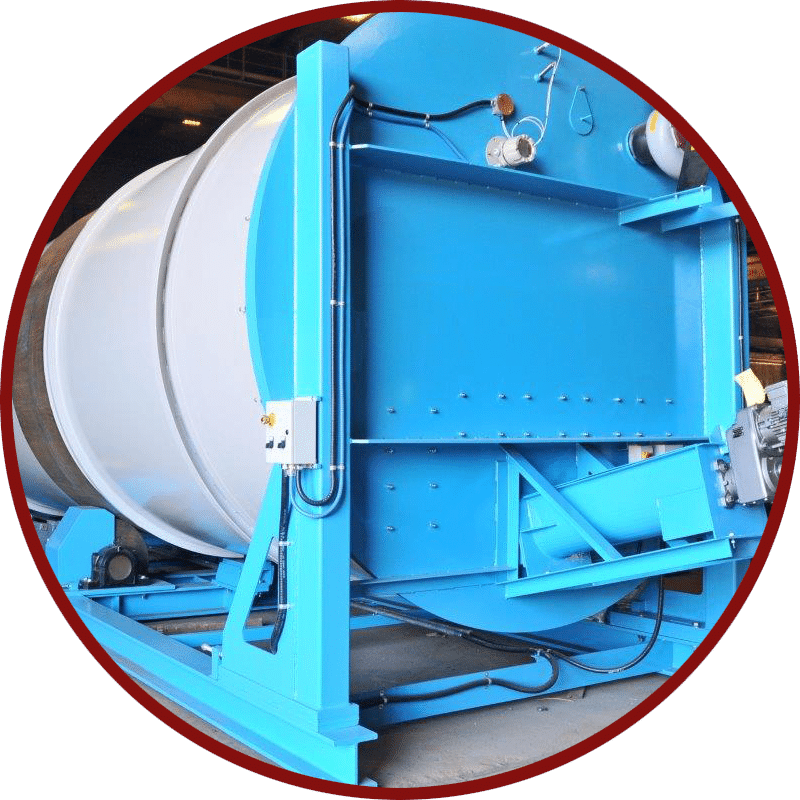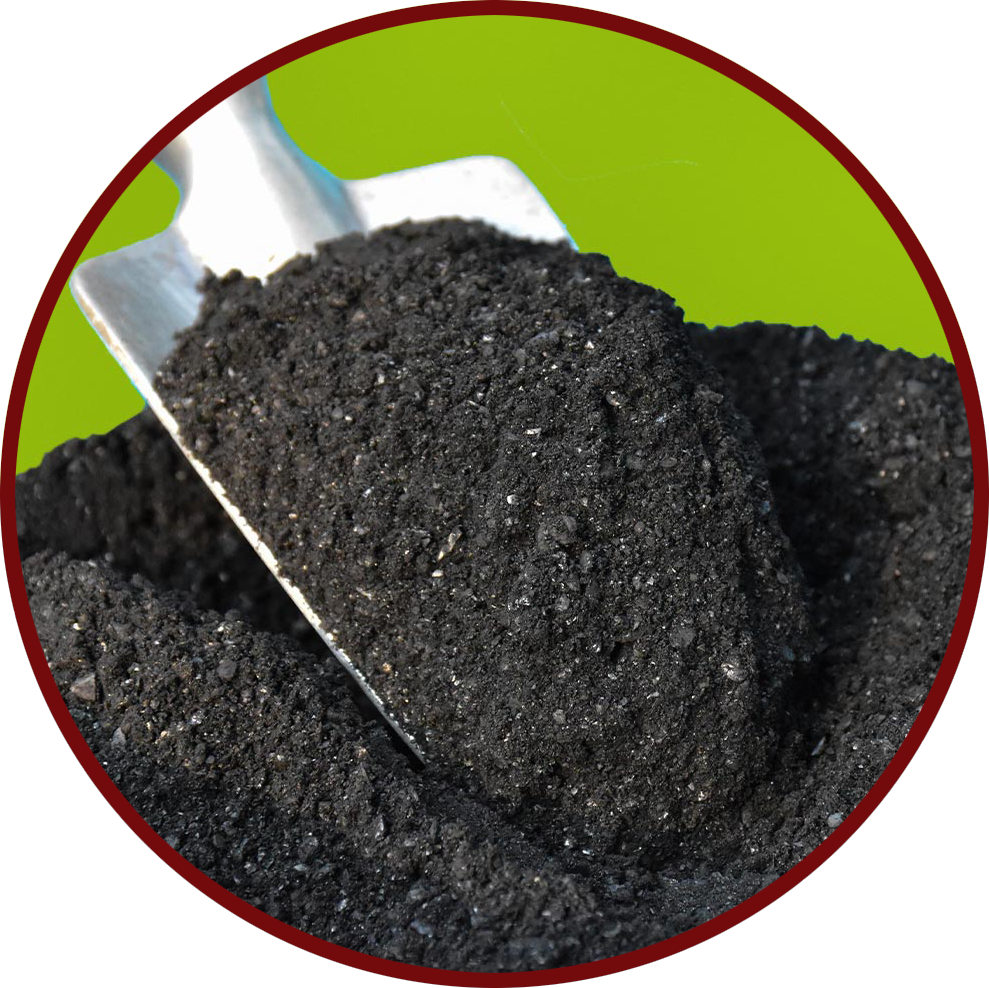Hi-YIELD
BIOFERTILZER
MADE FROM REPURPOSED HORSE WASTEHiPoint’s biomass is created using an accelerated bioreactor to produce Biofertilizers with biochar sold in bulk or bags. This process, when compared to traditional composting (that uses outdoor windrows), saves time, decreases land use acquisition, and prevents leaching and off-gassing into the environment.
HI-YIELD
BIOFERTILIZERHi-YIELD BIOFERTILIZER
MANUFACTURED LOCALLY FOR AGRICULTURE FROM AGRICULTURE
Hi-Yield biofertilizer
Manufactured Locally for Agriculture from agriculture
Premium quality

Premium quality
In our process, the lignocellulosic biomass and organic matter (volatile solids) are separated and processed independently, leaving the remaining product composed of manure buns, water, fines, and organic dust to reach the bioreactors. This results in hi-grade organic matter biofertilizer in as little as five days.


Bioreactor Process
The manure buns and organic matter fines are processed in a covered bioreactor to become inert and cured to be used. Unlike most composting operations that can take a year to breakdown wood shavings, our bioreactor can do it in 5 days, saving time, land, and money.
Bioreactor Process
The manure buns and organic matter fines are processed in a covered bioreactor to become inert and cured to be used. Unlike most composting operations that can take a year to breakdown wood shavings, our bioreactor can do it in 5 days, saving time, land, and money.

Marketing Sales channels
The biofertilizer market for soil health and root crop biofertilizers is expected to reach $1000 million by 2027, with a growth rate of 14.3%
HiPoint sells it's biofertilizer, supplemented with biochar, to horse farms, racetracks, landscapers, golf courses, county contracts, and polo fields. The product is designed to improve the soil and grounds by providing high-quality fertilizer and soil enhancements while reducing reliance on chemical fertilizers and irresponsible alternatives.

Market & Sales channels
The biofertilizer market for soil health and root crop biofertilizers is expected to reach $1000 million by 2027, with a growth rate of 14.3%
HiPoint offers its biofertilizer, supplemented with biochar, to horse farms, racetracks, landscapers, golf courses, county contracts, and polo fields. The product is designed to improve the soil and grounds by providing high-quality fertilizer and soil enhancements while reducing reliance on chemical fertilizers and irresponsible alternatives.


Benefits of Manure Based Biofertilizers
When compared to more conventional fertilizer, manure based Biofertilizer applied adequately to land has the potential to provide environmental, agricultural, and functional benefits, including but not limited to:
- Increased soil carbon and reduced atmospheric carbon levels.
- Reduced soil erosion by ~50% and runoff ~30% on average.
- Reduced nitrate leaching.
- Reduced energy demands for natural gas-intensive nitrogen(N) fertilizers.
Benefits of Manure Based Biofertilizers
When compared to more conventional fertilizer, manure based Biofertilizer applied adequately to land has the potential to provide environmental, agricultural, and functional benefits, including but not limited to:
- Increased soil carbon and reduced atmospheric carbon levels.
- Reduced soil erosion by ~50% and runoff ~30% on average.
- Reduced nitrate leaching.
- Reduced energy demands for natural gas-intensive nitrogen(N) fertilizers.

Regenerative Agriculture
Organic fertilizers offer better crop yields and soil stability than chemical fertilizers. HiPoint produces high-yield organic soil amendments using an accelerated bioreactor. Manure has significant value due to its nutrients, organic matter, and energy potential. It can be used as a resource for crop production, soil quality improvement, and other purposes, leading to water quality improvements. Manure has environmental benefits over commercial fertilizer, including increased soil carbon, reduced soil erosion and runoff, and increased nutrient retention.

Regenerative Agriculture
Organic fertilizers offer better crop yields and soil stability than chemical fertilizers. HiPoint produces high-yield organic soil amendments using an accelerated bioreactor. Manure has significant value due to its nutrients, organic matter, and energy potential. It can be used as a resource for crop production, soil quality improvement, and other purposes, leading to water quality improvements. Manure has environmental benefits over commercial fertilizer, including increased soil carbon, reduced soil erosion and runoff, and increased nutrient retention.


Integrity of the soil
An extensive literature review around the United States suggested that use of manure biofertilizer over chemical fertilizers substantially reduced soil erosion (13%-77%) and runoff (1%-68%) and in following years, application benefited from past application. Manure if applied according to a sound nutrient plan, has environmental benefits over commercial fertilizer.
"The use of Organic Matter Biofertilizers protects the integrity of the track and the health of the Horse."
integrity of the soil
An extensive literature review around the United States suggested that use of manure biofertilizer over chemical fertilizers substantially reduced soil erosion (13%-77%) and runoff (1%-68%) and in following years, application benefited from past application. Manure if applied according to a sound nutrient plan, has environmental benefits over commercial fertilizer.
The use of Organic Matter Biofertilizers protects the integrity of the track and the health of the Horse.

Organic Nitrogen Value
Organic Nitrogen (manure N tied to organic compounds) is more stable than N applied as commercial [chemical] fertilizer. Manure nitrogen is a natural slow-release form that is better timed to the crop's nitrogen needs, resulting in less leaching potential. Commercial fertilizer nitrogen, either nitrate or ammonium, is easily converted to nitrate and contributes to leaching during excess precipitation or irrigation.

Organic Nitrogen Value
Organic Nitrogen (manure N tied to organic compounds) is more stable than N applied as commercial [chemical] fertilizer. Manure nitrogen is a natural slow-release form that is better timed to the crop's nitrogen needs, resulting in less leaching potential. Commercial fertilizer nitrogen, either nitrate or ammonium, is easily converted to nitrate and contributes to leaching during excess precipitation or irrigation.


Carbon Sequestration
Carbon farming is a set of agricultural methods that aim to store carbon in the soil, crop roots, wood and leaves. The technical term for this is carbon sequestration. The overall goal of carbon farming is to create a net loss of carbon from the atmosphere. This is done by increasing the rate at which carbon is sequestered into soil and plant material. One option is to increase the soil's organic matter content. This can also aid plant growth, improve soil water retention capacity and reduce fertilizer use. Sustainable forest management is another tool that is used in carbon farming. Carbon farming is a component of climate-smart agriculture and a method for removing carbon dioxide (CDR).
Carbon Sequestration
Carbon farming is a set of agricultural methods that aim to store carbon in the soil, crop roots, wood and leaves. The technical term for this is carbon sequestration. The overall goal of carbon farming is to create a net loss of carbon from the atmosphere. This is done by increasing the rate at which carbon is sequestered into soil and plant material. One option is to increase the soil's organic matter content. This can also aid plant growth, improve soil water retention capacity and reduce fertilizer use. Sustainable forest management is another tool that is used in carbon farming. Carbon farming is a component of climate-smart agriculture and a method for removing carbon dioxide (CDR).

NPK Balanced. Hi-Yield BioFertilizer. With Biochar.
What Is Biochar & Why does HiPoint add it to Biofertilizer
Biochar systems are complex and require further research and life cycle analysis to understand the opportunities and risks associated with them in developing countries. Four main factors need to be considered:
1. Impacts on soil health and agricultural productivity, such as soil pH, nutrient availability, soil moisture, soil organic matter, and the amount of biochar applied.
2. Impacts on climate change, including carbon storage and stabilization, which are the most important factors for climate change mitigation efforts based on biochar. Biomass cookstoves are significant sources of black carbon, which could have a global impact on the climate and human health. The risks of negative climate impact related to biochar lie primarily in the negative feedback that may occur during biochar production and application, such as emissions of methane and nitrous oxide during inefficient pyrolysis and degradation of soil organic matter after biochar application.
ref: greenfacts.org edited AI to shorten
3. Social impacts, including effects on energy, health, economics, and food security. Biochar use can reduce pressure on wooded ecosystems and decrease the burden of fuel gathering. Improved cookstoves can also reduce indoor air pollution throughout the developing world, especially for women and children. In addition, biochar systems could help buffer practitioners against crop shortages and hunger by improving crop yields or crop resilience. The energy produced from biochar could potentially be used for critical functions such as the refrigeration of vaccines, water pumping, and lighting after sunset. Risks of biochar use can include potential emission of toxins and inhalation of dust and small particulate matter.
4. Competing uses of biomass. The use of dedicated energy crops for biochar production could divert food crops for fuel production, divert arable land from food crops, and affect direct and indirect land use change. The costs and benefits must, therefore, be weighed, of leaving biomass in situ versus using it to produce biochar that is then added to the soil. Biochar is one of the few GHG reduction strategies that can actually withdraw carbon dioxide from the atmosphere. It has significant advantages but can have an overall net climate impact.
What Is Biochar & Why does HiPoint add it to Biofertilizer
Biochar systems are complex and require further research and life cycle analysis to understand the opportunities and risks associated with them in developing countries. Four main factors need to be considered:
1. Impacts on soil health and agricultural productivity, such as soil pH, nutrient availability, soil moisture, soil organic matter, and the amount of biochar applied.
2. Impacts on climate change, including carbon storage and stabilization, which are the most important factors for climate change mitigation efforts based on biochar. Biomass cookstoves are significant sources of black carbon, which could have a global impact on the climate and human health. The risks of negative climate impact related to biochar lie primarily in the negative feedback that may occur during biochar production and application, such as emissions of methane and nitrous oxide during inefficient pyrolysis and degradation of soil organic matter after biochar application.
3. Social impacts, including effects on energy, health, economics, and food security. Biochar use can reduce pressure on wooded ecosystems and decrease the burden of fuel gathering. Improved cookstoves can also reduce indoor air pollution throughout the developing world, especially for women and children. In addition, biochar systems could help buffer practitioners against crop shortages and hunger by improving crop yields or crop resilience. The energy produced from biochar could potentially be used for critical functions such as the refrigeration of vaccines, water pumping, and lighting after sunset. Risks of biochar use can include potential emission of toxins and inhalation of dust and small particulate matter.
4. Competing uses of biomass. The use of dedicated energy crops for biochar production could divert food crops for fuel production, divert arable land from food crops, and affect direct and indirect land use change. The costs and benefits must, therefore, be weighed, of leaving biomass in situ versus using it to produce biochar that is then added to the soil. Biochar is one of the few GHG reduction strategies that can actually withdraw carbon dioxide from the atmosphere. It has significant advantages, but the overall net climate impact of biochar requires a full life-cycle assessment to determine whether it is beneficial or not.
